The Influencing Factors of Enterprise Sustainable Innovation: An Empirical Study
Abstract
:1. Introduction
2. Literature Review
- (1)
- Persistence. The sustainable innovation is a process. It has a time duration.
- (2)
- Sustainable economic growth. The innovation theory tells us that innovation should bring economic benefits. Similarly, sustainable innovation should bring the continual growth of economic benefits.
- (3)
- Sustainable development of enterprises. According to Schumpeter’s view [4], innovation means development. Therefore, sustainable innovation should lead to the continual improvement of an enterprise’s economic power, technological power, and business scale.
- (1)
- Scholars have defined sustainable innovation from different aspects. They have different focuses and each has its advantages. However, until now there is no consensus on what is sustainable innovation, and most definitions have not clearly shown the nature of sustainable innovation. For example, it has not emphasized such characteristics of sustainable innovation as persistence, dynamics, and human orientation. Sustainable innovation is an ongoing innovation. It is not transient and occasional innovation [5]. We should focus on the persistence of sustainable innovation. Sustainable innovation is a fundamental task of organizations in a dynamic and unstable environment. We also should pay attention to the dynamic nature of sustainable innovation. In terms of sustainable innovation, the knowledge of employees is the most important resource for enterprises [16]. Their innovative behaviors and learning activities are keys for the sustainable innovation of an organization. Hence, the definition of sustainable innovation should focus attention on the subject of innovation. Any activity that serves a certain purpose. The continuous increase of enterprises’ economic benefits comes from sustainable innovation behaviors. The sustainable development of enterprises also depends on sustainable innovation. However, how the motivation of knowledgable workers’ innovative behaviors can influence sustainable innovation is hardly discussed in the previous literatures.
- (2)
- Some scholars have not differentiated the sustainable innovation capability from the technological innovation capability. Technological innovation refers to development of new technology or the application of innovation to the present technology. In fact, technological innovation capability is part of sustainable innovation capability. By analyzing the preceding literature [12,13,14,15], we propose that sustainable innovation capability is a synthesized capability. It is an innovation system, which is composed of all kinds of innovation capabilities. Through the interaction of all kinds of innovation capabilities, it can improve the enterprises’ sustainable innovation capability and promote the sustainable development of enterprises. Generally speaking, sustainable innovation capability should incorporate sustainable technological innovation capability, production innovation capability which applies new technologies to practice, and market innovation capability which can turn the new products and new services into enterprise profits.
- (3)
- Scholars mainly synthesize the literature review and empirical analysis to examine the factors influencing sustainable innovation, but the empirical sample is relatively quite small. There is also a lack of practical cases to test the results of these empirical studies.
3. Empirical Analysis of the Influencing Factors of Enterprise Sustainable Innovation
3.1. Hypotheses and Model
3.1.1. The Constitution of Sustainable Innovation Capability
3.1.2. The Sustainable Innovation Indicator System
3.1.3. The Influence of Incentive Mechanisms on Sustainable Innovation
3.1.4. The Influence of Knowledge on Sustainable Innovation
3.2. Questionnaire Design and Data Sources
3.3. Data Analysis
3.3.1. Reliability Analysis
3.3.2. Validity Analysis
3.3.3. Testing of the Theoretical Model
4. Case Analysis of the Influencing Factors of Sustainable Innovation
4.1. Brief Introduction
4.2. System Boundary and the Construction of Stock and Flow Diagrams
4.3. Analysis of the Simulation Results
5. Discussion
- (1)
- Defining what is sustainable innovation and its characteristics. Sustainable innovation indicates the process of which within a long period, depending on the continuous learning of its employees, the enterprise continuously implements innovative integration of its key resources (knowledge, production, and market) to obtain uninterrupted growth and sustainable development. It has the following characteristics: persistence, human orientation, a dynamic and systematic nature, continuous growth of economic benefits, and sustainable development of enterprises.
- (2)
- Carrying out the empirical study on the factors influencing sustainable innovation. The factors which influence sustainable innovation are diverse and complicated. We believe the internal factors are the fundamental ones. Based on innovation theory, dynamic capability theory, and knowledge-based theory, this paper establishes a theoretical framework of the factors influencing sustainable innovation.
- (3)
- Carrying out a case study on the factors influencing sustainable innovation. Taking JMC as an example, based on a system dynamics model, this paper has tested the effectiveness of the theoretical framework of sustainable innovation factors. The simulation results demonstrate that, from 2005–2014, the curve matches with the reality of JMC. Furthermore, it forecasts the future development of JMC in the next five years. The case study further proves that the theoretical framework this paper builds has high applicability.
6. Conclusions
Supplementary Materials
Acknowledgments
Conflicts of Interest
Abbreviations
| JMC | Jiangling Motors Co., Ltd. |
References
- Peteraf, M.A. The cornerstones of competitive advantage: A resource—Based view. Strateg. Manag. J. 1993, 14, 179–191. [Google Scholar] [CrossRef]
- De Geus, A. The Living Company: Habits for Survival in a Turbulent Environment; Nicholas Brealey: London, UK, 1997; pp. 1–26. [Google Scholar]
- Adizes, I. Enterprise Life Cycle; Chinese Social Sciences Publishing House: Beijing, China, 1997; pp. 10–36. [Google Scholar]
- Schumpeter, J.A. Business Cycles; McGraw-Hill: New York, NY, USA, 1939; pp. 61–74. [Google Scholar]
- Xue, H. Study on the Mechanism of Continuous Innovation of Innovation-Oriented Enterprises. Ph.D. Thesis, Hefei University of Technology, Hefei, China, 2010. [Google Scholar]
- Porter, M.E. Competitive strategy. Meas. Bus. Excell. 1997, 1, 12–17. [Google Scholar] [CrossRef]
- Teece, D.J.; Pisano, G.; Shuen, A. Dynamic capabilities and strategic management. Strategic Manag. J. 1997, 18, 509–533. [Google Scholar] [CrossRef]
- Boer, H.; Gertsen, F. From continuous improvement to continuous innovation: A (retro) (per) spective. Int. J. Technol. Manag. 2003, 26, 805–827. [Google Scholar] [CrossRef]
- Lin, C.Y.; Kuo, T.H. The mediate effect of learning and knowledge on organizational performance. Ind. Manag. Data Syst. 2007, 107, 1066–1083. [Google Scholar] [CrossRef]
- Smeds, R.; Boer, H. Continuous innovation and learning in industrial organizations. Knowl. Process Manag. 2004, 11, 225–227. [Google Scholar] [CrossRef]
- Xiang, G. Some thinking about the enterprise’s sustainable innovation. In Proceedings of the China-USA Seminar on the Technological Innovation Management 2000 the International Conference, Beijing, China, 24–27 April 2000; pp. 296–303.
- Xiang, G.; Long, J. Discussion on the operation rules, development tendency and management mechanism of continuous innovation process of state-owned enterprises. Inq. Econ. Issues 2002, 1, 12–19. [Google Scholar]
- Soosay, C.A. An empirical study of individual competencies in distribution centres to enable continuous innovation. Creat. Innov. Manag. 2005, 14, 299–310. [Google Scholar] [CrossRef]
- Chen, S.; He, W. Study on Knowledge Propagation in Complex Networks Based on Preferences—Taking Wechat as Example. Abstr. Appl. Anal. 2014, 2014, 1–11. [Google Scholar] [CrossRef]
- Chen, S.; Xu, S.; Lee, C.; Xiong, N.N.; He, W. The study on stage financing model of IT project investment. Sci. World J. 2014, 2014. [Google Scholar] [CrossRef] [PubMed]
- Long, X. The Research of Knowledge Employees’ Immaterial Motivation Mechanism and Innovation Performance. Ph.D. Thesis, Central South University, Changsha, China, 2012. [Google Scholar]
- Cole, R.E. From continuous improvement to continuous innovation. Total Qual. Manag. 2002, 13, 1051–1056. [Google Scholar] [CrossRef]
- Boer, H.; Caffyn, S.; Corso, M. Knowledge and continuous innovation: The CIMA methodology. Int. J. Oper. Prod. Manag. 1980, 21, 490–504. [Google Scholar] [CrossRef]
- Xu, J.; Houssin, R.; Caillaud, E.; Gardoni, M. Macro process of knowledge management for continuous innovation. J. Knowl. Manag. 2010, 14, 573–591. [Google Scholar] [CrossRef]
- Chen, S. A novel culture algorithm and its application in knowledge integration. Int. Inf. Inst. (Tokyo). Inf. 2012, 15, 4847–4854. [Google Scholar]
- Liao, S.H.; Wu, C. System perspective of knowledge management, organizational learning, and organizational innovation. Expert Syst. Appl. 2010, 37, 1096–1103. [Google Scholar] [CrossRef]
- He, W. An inventory controlled supply chain model based on improved BP neural network. Discret. Dyn. Nat. Soc. 2013, 2013. [Google Scholar] [CrossRef]
- Chen, S. Empirical Research on Knowledge Integration Improving Innovation Ability of IT Enterprise-Based on Structural Equation Model. Inf. Int. Interdiscip. J. 2011, 14, 753–758. [Google Scholar]
- Qi, L.; Song, X. Study on the evaluation of continuous innovation capability based on AHP theory. Mod. Enterp. Cult. 2011, 9, 64–65. [Google Scholar]
- Li, Z.; Huang, Y. The study on the continuous model of continuous innovation. Technoecon. Manag. Res. 2009, 6, 56–58. [Google Scholar]
- Guan, J.C.; Yam, R.C.M.; Mok, C.K.; Ma, N. A study of the relationship between competitiveness and technological innovation capability based on DEA models. Eur. J. Oper. Res. 2006, 170, 971–986. [Google Scholar] [CrossRef]
- Lawson, B.; Samson, D. Developing innovation capability in organisations: A dynamic capabilities approach. Int. J. Innov. Manag. 2001, 5, 377–400. [Google Scholar] [CrossRef]
- Cao, W. Research of Continuous Innovation Ability of Science and Technology Enterprises. Ph.D. Thesis, Hunan University, Changsha, China, 2014. [Google Scholar]
- Su, Y.; He, H.; Yi, J. Research on Evaluation System of Enterprise’s Sustainable Innovation Capability. Sci. Technol. Prog. Policy 2009, 20, 139–145. [Google Scholar]
- Li, X. Study on Indicator System of Sustainable Innovation Power, Ability, Performance. Ph.D. Thesis, Kunming University of Science and Technology, Kunming, China, 2008. [Google Scholar]
- Gang, X.; Wang, Y. Capabilities of the Enterprise’s Sustainable Innovation: Key Factors and Evaluation Model. Chin. J. Manag. Sci. 2004, 12, 137–142. [Google Scholar]
- Seidler-de Alwis, R.; Hartmann, E. The use of tacit knowledge within innovative companies: Knowledge management in innovative enterprises. J. Knowl. Manag. 2008, 12, 133–147. [Google Scholar] [CrossRef]
- Schumpeter, J.A. The Theory of Economic Progress; Chinese Version; Beijing Publisher: Beijing China, 2009; pp. 10–37. [Google Scholar]
- Schumpeter, J.A.; Opie, R. The Theory of Economic Development. An Inquiry into Profits, Capital, Credit, Interest, and the Business Cycle; Harvard University Press: Cambridge, MA, USA, 1934; pp. 393–397. [Google Scholar]
- Harris, T.G. The post-capitalist executive: An interview with Peter F. Drucker. Harv. Bus. Rev. 1993, 71, 114–122. [Google Scholar]
- Cao, W.; Shan, M. Influential Factors of Continuous Innovation Capability for Small and Medium Enterprises of Science and Technology. J. Beijing Inst. Technol. (Soc. Sci. Ed.) 2013, 15, 70–76. [Google Scholar]
- Rui, M.; Fang, T. Knowledge and Sustained Competitive Advantages of the Firm. J. Fudan Univ. (Nat. Sci.) 2003, 5, 721–727. [Google Scholar]
- He, W. China technology innovation strategy-from technology transfer perspective. Inf. Int. Interdiscip. J. 2012, 15, 4841–4846. [Google Scholar]
- Drucker, P.F. Knowledge—Worker productivity: The biggest challenge. Calif. Manag. Rev. 1999, 41, 79–94. [Google Scholar] [CrossRef]
- Snell, S.A.; Dean, J.W. Integrated manufacturing and human resource management: A human capital perspective. Acad. Manag. J. 1992, 35, 467–504. [Google Scholar] [CrossRef]
- Afuah, A. Innovation Management: Strategies, Implementation and Profits; Oxford University Press: Oxford, UK, 2003; pp. 578–580. [Google Scholar]
- Amabile, T.M. A model of creativity and innovation in organizations. Res. Organ. Behav. 1988, 10, 123–167. [Google Scholar]
- Schuler, R.S.; Jackson, S.E. Linking competitive strategies with human resource management practices. Acad. Manag. Executive 1987, 1, 207–219. [Google Scholar] [CrossRef]
- Carmen, C.O.; María de la Luz, F.A.; Salustiano, M.F. Influence of top management team vision and work team characteristics on innovation: The Spanish case. Eur. J. Innov. Manag. 2006, 9, 179–201. [Google Scholar] [CrossRef]
- Carpinetti, L.C.R.; Gerolamo, M.C.; Galdámez, E.V.C. Continuous innovation and performance management of SME clusters. Creat. Innov. Manag. 2007, 16, 376–385. [Google Scholar] [CrossRef]
- He, W.; Chen, S.H. Game analysis of determinants of stability of semiconductor modular production networks. Sustainability 2014, 6, 4772–4794. [Google Scholar] [CrossRef]
- Inkpen, A.C. Learning through joint ventures: A framework of knowledge acquisition. J. Manag. Stud. 2000, 37, 1019–1044. [Google Scholar] [CrossRef]
- Turner, K.L.; Makhija, M.V. The role of organizational controls in managing knowledge. Acad. Manag. Rev. 2006, 31, 197–217. [Google Scholar] [CrossRef]
- Mitchell, V.L. Knowledge integration and information technology project performance. MIS Q. 2006, 30, 919–939. [Google Scholar]
- Alavi, M.; Tiwana, A. Knowledge integration in virtual teams: The potential role of KMS. J. Am. Soc. Inf. Sci. Technol. 2002, 53, 1029–1037. [Google Scholar] [CrossRef]
- Majchrzak, A.; Cooper, L.P.; Neece, O.E. Knowledge reuse for innovation. Manag. Sci. 2004, 50, 174–188. [Google Scholar] [CrossRef]
- Choi, S.Y.; Lee, H.; Yoo, Y. The Impact of Information Technology and Transactive Memory Systems on Knowledge Sharing, Application, and Team Performance: A Field Study. MIS Q. 2010, 34, 855–870. [Google Scholar]
- Marsh, H.W.; Balla, J.R.; McDonald, R.P. Goodness-of-fit indexes in confirmatory factor analysis: The effect of sample size. Psychol. Bull. 1988, 103, 391–410. [Google Scholar] [CrossRef]
- Drucker, P. Knowledge Management; Renming University Press: Beijing, China, 1999; pp. 12–25. [Google Scholar]
- Dahl, M.S.; Pedersen, C.R. Knowledge flows through informal contacts in industrial clusters: Myth or reality? Res. Policy 2004, 33, 1673–1686. [Google Scholar] [CrossRef]
- Smith, K.G.; Collins, C.J.; Clark, K.D. Existing knowledge, knowledge creation capability, and the rate of new product introduction in high-technology firms. Acad. Manag. J. 2005, 48, 346–357. [Google Scholar] [CrossRef]
- Gold, A.H.; Malhotra, A.; Segars, A.H. Knowledge management: An organizational capabilities perspective. J. Manag. Inf. Syst. 2001, 18, 185–214. [Google Scholar]
- Wang, Y.; Chen, Y.; Lei, J. Empirical study on the relationship between technological innovation capability of IT enterprises and enterprise growth. Stud. Sci. Sci. 2010, 28, 316–320. [Google Scholar]
- Amos, J.W.; Gibson, D.V. An exploratory model of agility: Key facilitators and performance metrics. In Proceedings of the 4th Annual Agility Forum: Creating the Agile Organization: Models, Metrics and Pilots, Atlanta, GA, USA, 7–9 March 1995; pp. 173–187.
- Upton, D.M. The Management of Manufacturing Flexibility. Calif. Manag. Rev. 1994, 36, 72–89. [Google Scholar] [CrossRef]
- Huang, H. Market Innovation; Qinghua University Press: Beijing, China, 1999; pp. 25–42. [Google Scholar]
- Xu, D. Study on Enterprise Market Innovation Organization Management. Master’s Thesis, Wuhan Institute of Technology, Wuhan, China, 2002. [Google Scholar]
- Sveiby, K. The New Organizational Wealth; Berrett Koehler: San Francisco, CA, USA, 1999; pp. 65–94. [Google Scholar]
- Muthén, B. A general structural equation model with dichotomous, ordered categorical, and continuous latent variable indicators. Psychometrika 1984, 49, 115–132. [Google Scholar] [CrossRef]
- Forrester, J.W. Industrial dynamics. J. Oper. Res. Soc. 1997, 48, 1037–1041. [Google Scholar] [CrossRef]
- Jia, R.; Ding, R. System Dynamics—Analysis of Feedback Dynamic Complexity; Higher Education: Beijing, China, 2002; pp. 26–30. [Google Scholar]

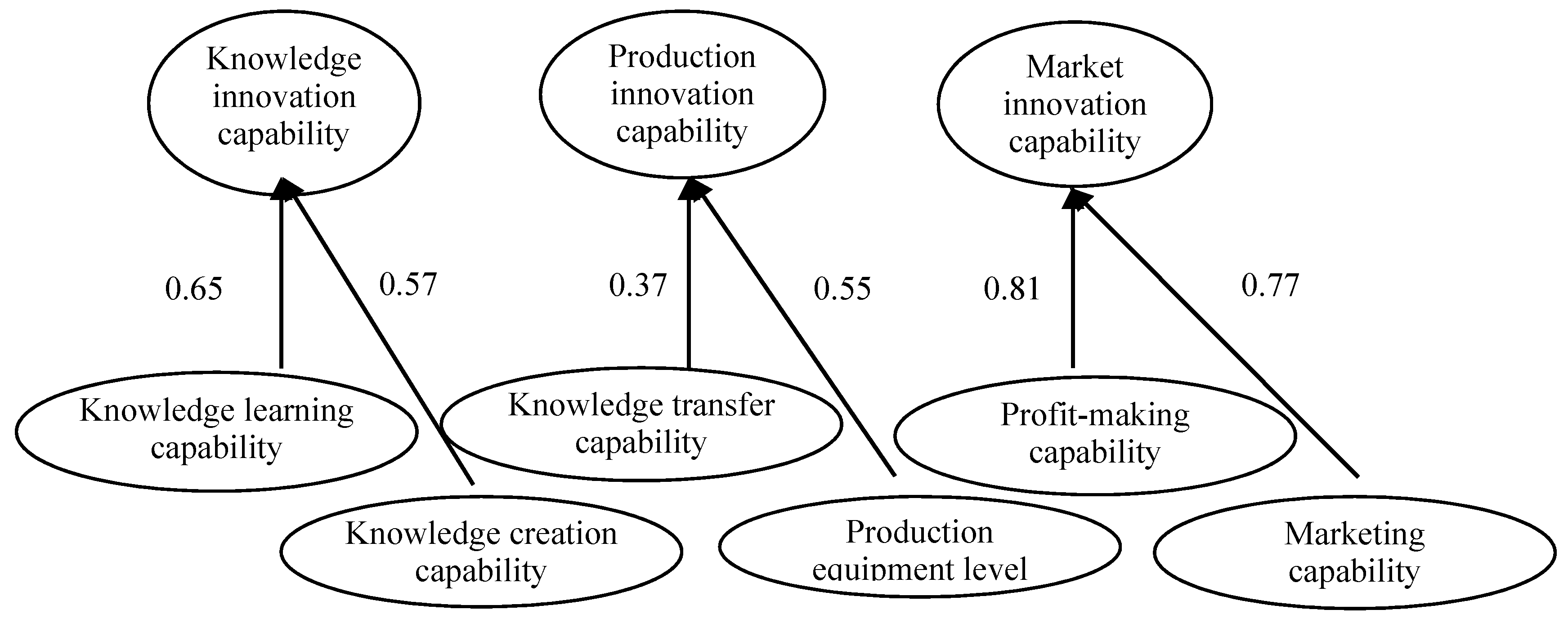

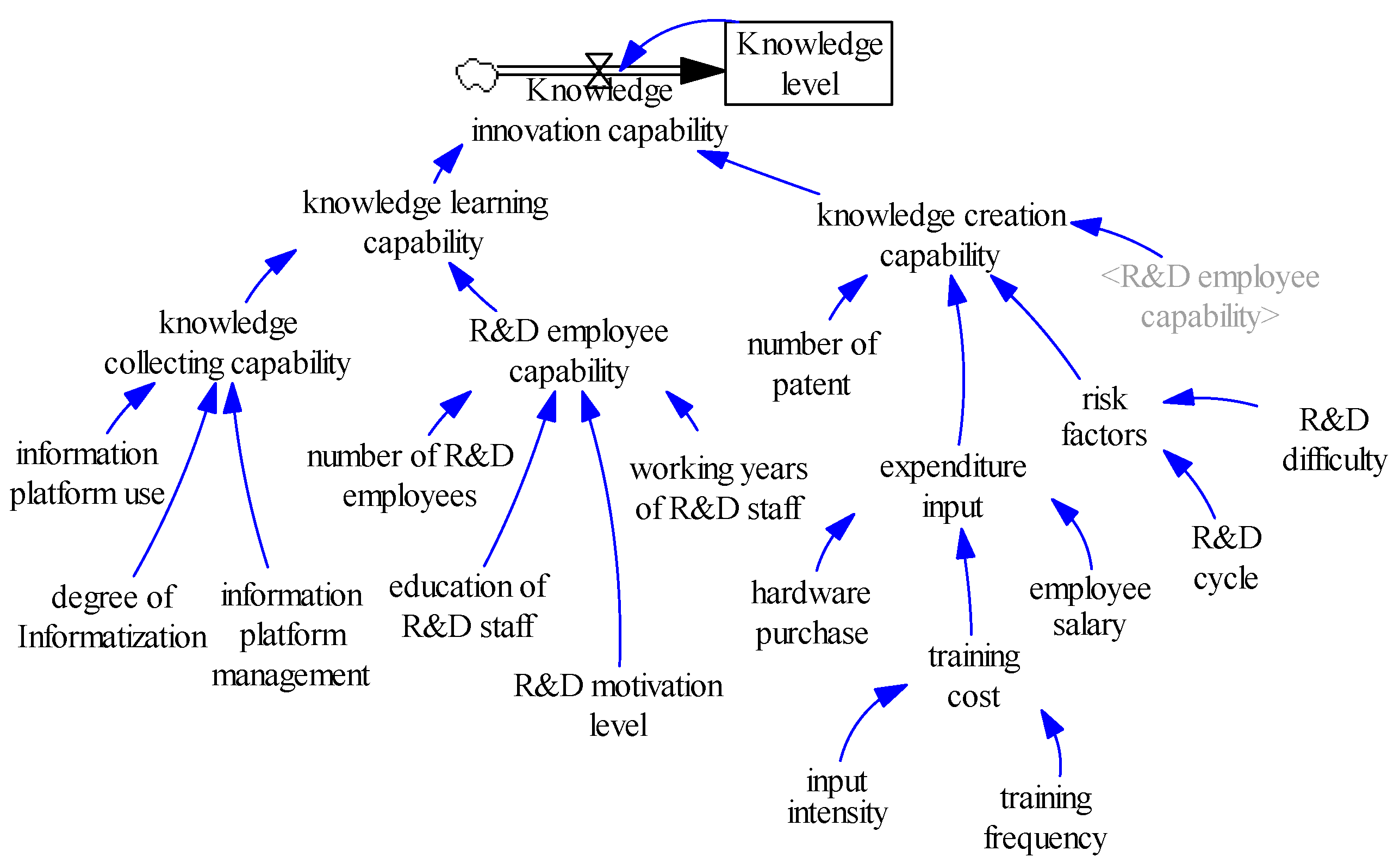

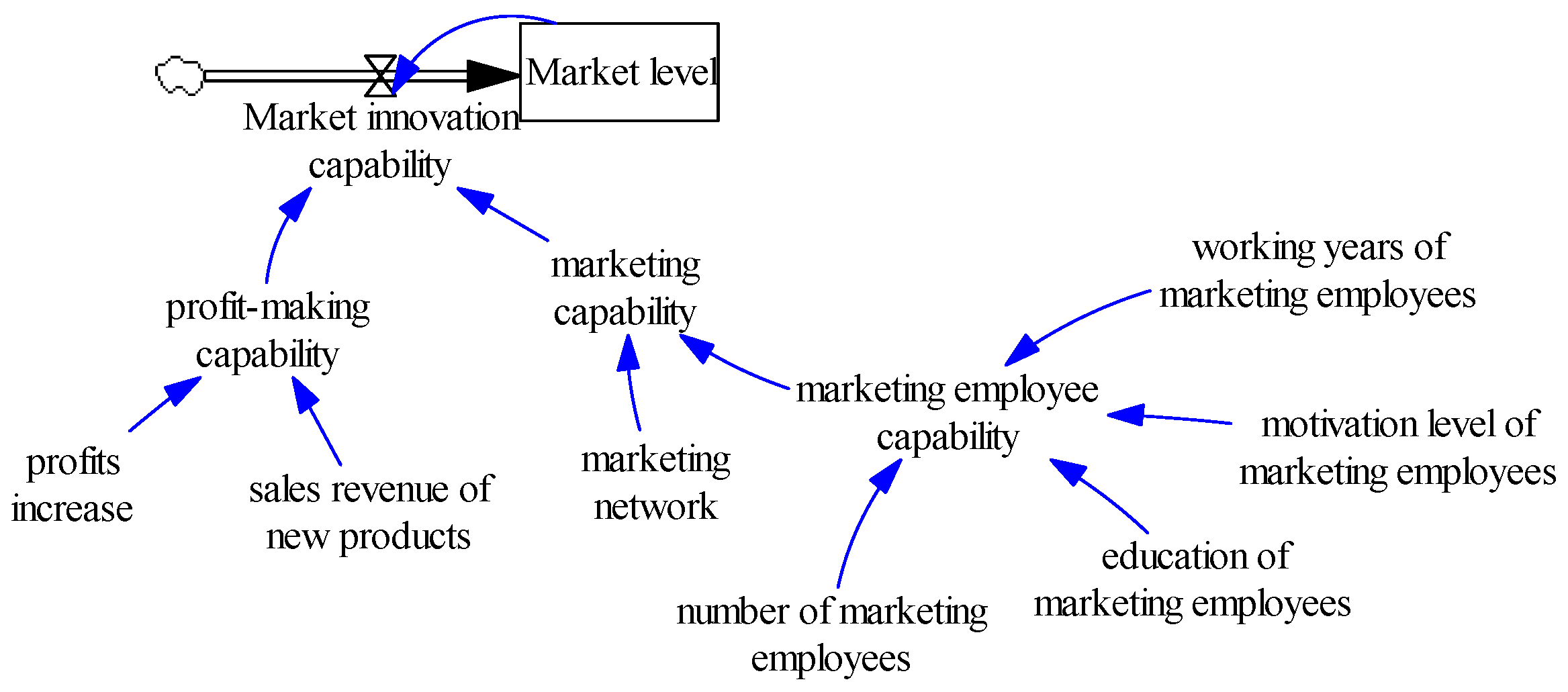
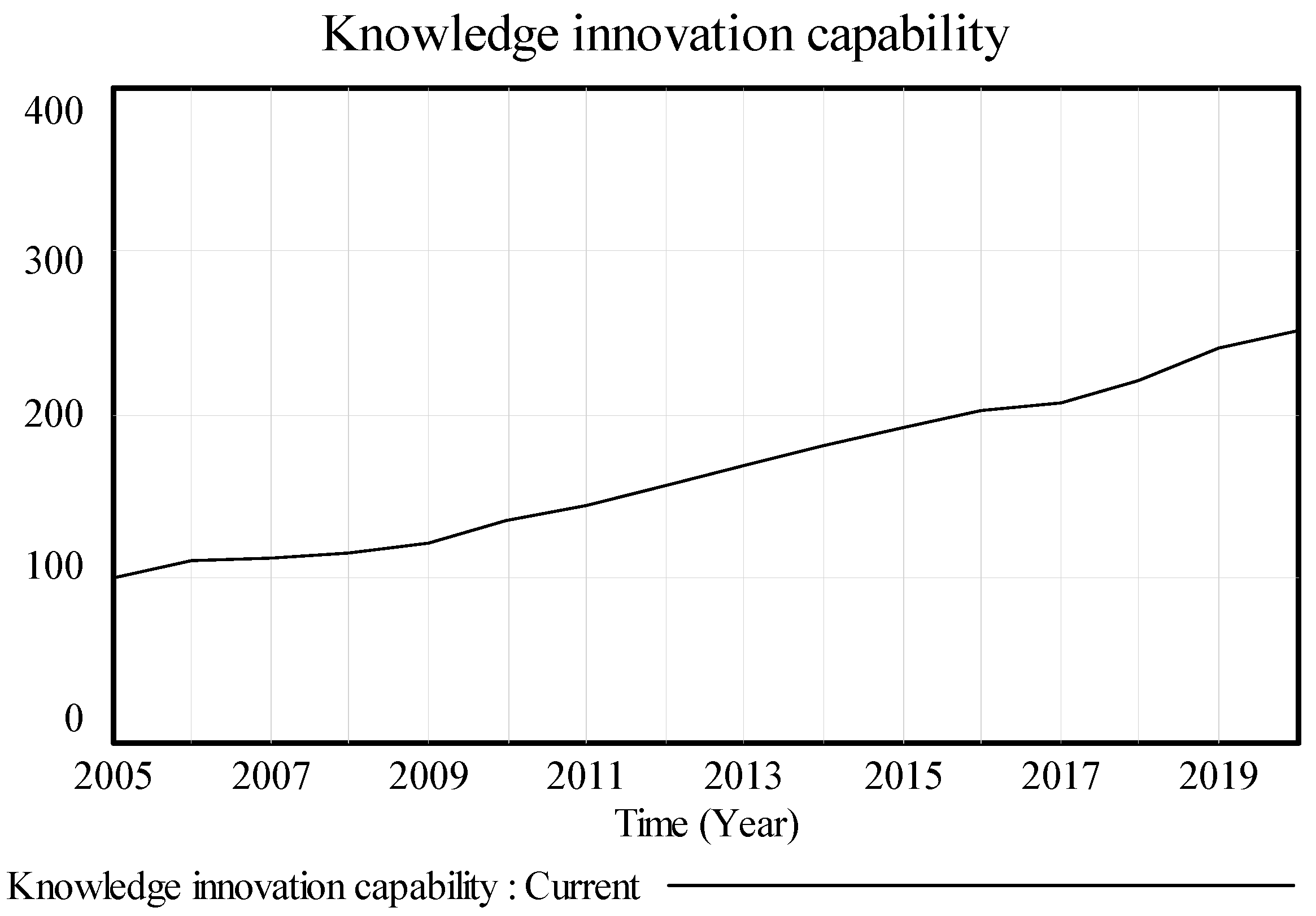
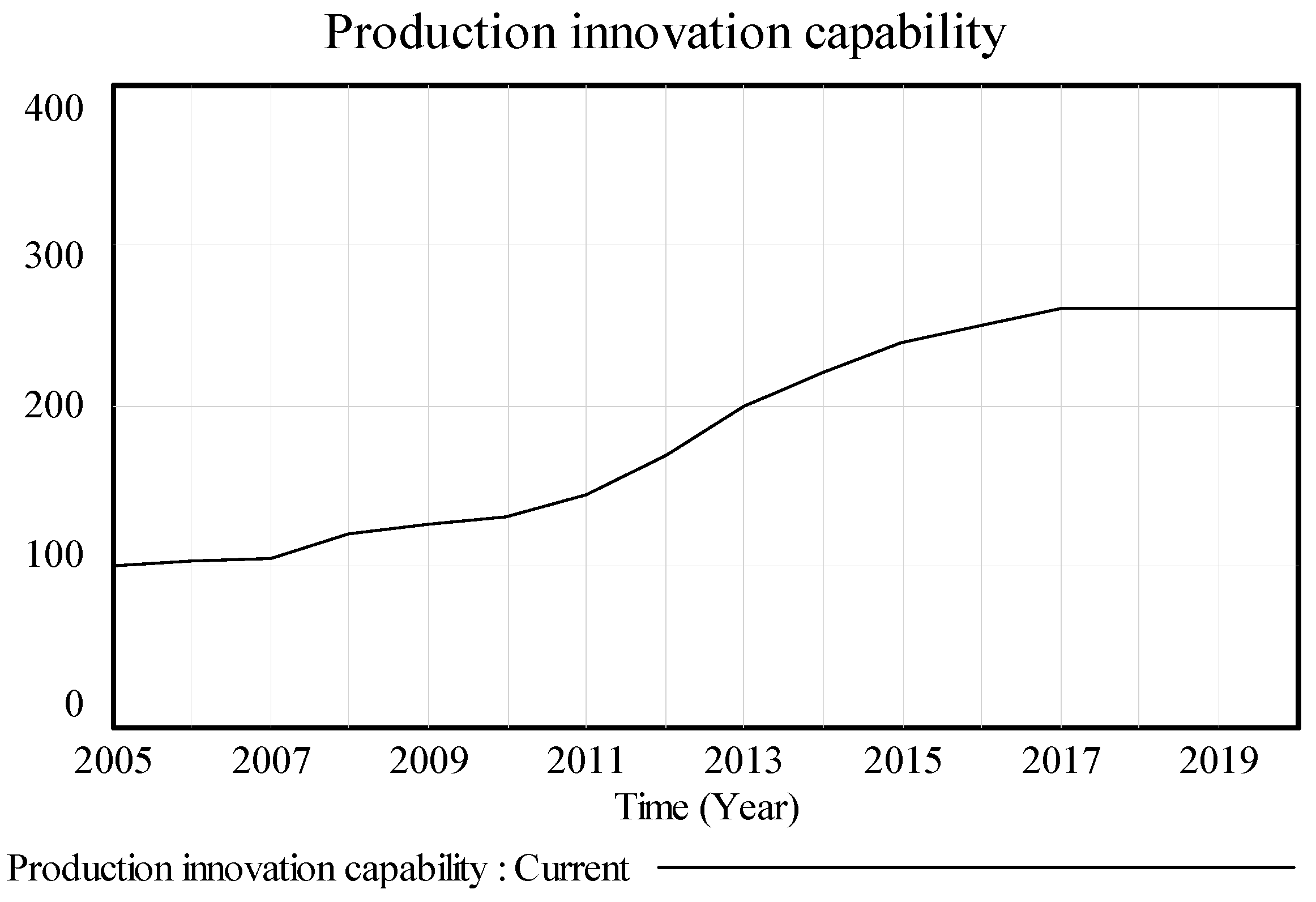

| Variable | Definition | Question | Source |
|---|---|---|---|
| Knowledge learning capability | Capability to acquire general knowledge | 4 | [54,55] |
| Knowledge creation capability | Unique knowledge creation capability | 3 | [56] |
| Knowledge transferring capability | Capability to transfer knowledge into new products and services | 3 | [57,58] |
| Production equipment level | Degree of advancement of production equipment | 1 | [58] |
| Profit-making capability | Revenues of new products and services | 2 | [59,60] |
| Marketing capability | Quality of market network and marketing employees | 2 | [61,62] |
| sustainable innovation capability | including knowledge innovation capability, production innovation capability, and market innovation capability | 3 | [57,63] |
| Variable | Question | Cronbach’s Alpha |
|---|---|---|
| Knowledge learning capability | 4 | 0.789 |
| Knowledge creation capability | 3 | 0.892 |
| Knowledge transferring capability | 3 | 0.837 |
| Production equipment level | 1 | 0.912 |
| Profit-making capability | 2 | 0.893 |
| Marketing capability | 2 | 0.821 |
| Sustainable innovation capability | 3 | 0.792 |
| Variable | KMO | Bartlett Chi-Square Sig | |
|---|---|---|---|
| Knowledge learning capability | 0.860 | 802.841 | 0.000 |
| Knowledge creation capability | 0.853 | 368.844 | 0.000 |
| Knowledge transferring capability | 0.726 | 179.544 | 0.000 |
| Production equipment level | 0.884 | 742.240 | 0.000 |
| Profit-making capability | 0.865 | 772.880 | 0.000 |
| Marketing capability | 0.881 | 703.208 | 0.000 |
| Sustainable innovation capability | 0.909 | 1036.371 | 0.000 |
| Indicator | Value | Receive Standard | Judgment | |
|---|---|---|---|---|
| Chi square test | CMIN | 0.08 | >0.05 | Accepted |
| CMINDF | 1.332 | <2 | Accepted | |
| Residual analysis | RMR | 0.17 | The smaller the better | Accepted |
| Fitness index | GFI | 0.97 | >0.85 | Accepted |
| AGFI | 0.93 | >0.90 | Accepted | |
| PGFI | 0.74 | >0.50 | Accepted | |
| NFI | 0.96 | >0.90 | Accepted | |
| IFI | 0.97 | >0.90 | Accepted | |
| Substitution | CFI | 0.967 | >0.90 | Accepted |
| RMSEA | 0.094 | The smaller the better | Accepted | |
| IFI | 0.945 | >0.90 | Accepted | |
| Hypothesis | Coefficient | p | Test Results | Hypothesis | Coefficient | p | Test Results |
|---|---|---|---|---|---|---|---|
| H1A | 0.65 | 0.000 | Support | H2B | 0.81 | 0.451 | Deny |
| H1B | 0.57 | 0.002 | Support | H2C | 0.37 | 0.001 | Support |
| H1C | 0.18 | 0.576 | Deny | H2D | 0.55 | 0.000 | Support |
| H1D | 0.19 | 0.612 | Deny | H3A | 0.81 | 0.000 | Support |
| H2A | 0.27 | 0.607 | Deny | H3B | 0.77 | 0.000 | Support |
| Item | Source | Item | Source |
|---|---|---|---|
| Degree of informatization | Q. No.1 | Input intensity | Q. No.6 |
| Information platform use | Q. No.2 | Training frequency | J.H.D. |
| Information platform management | Q. No.3 | Employee salary | J.H.D. |
| Number of R&D employees | J.H.D. | R&D cycle | J.H.D. |
| Education of R&D staff | J.H.D. | R&D difficulty | Q. No.7 |
| R&D motivation level | J.H.D. | Equipment level | Q. No.8 |
| Working years of R&D staff | J.H.D. | Number of brands | J.H.D. |
| Number of patents | J.H.D. | Transferring risk | J.H.D. |
| Hardware purchases | J.H.D. | Sales revenue of new products | J.H.D. |
| Number of production knowledge employees | J.H.D. | Working years of production knowledge employees | J.H.D. |
| Education of production knowledge employees | J.H.D. | Working years of marketing employees | J.H.D. |
| Motivation level of production knowledge employees | J.H.D. | Motivation level of marketing employees | J.H.D. |
| Marketing network | Q. No.14 | Number of marketing employees | J.H.D. |
| Profit increase | J.H.D. | Education of marketing employees | J.H.D. |
© 2016 by the author; licensee MDPI, Basel, Switzerland. This article is an open access article distributed under the terms and conditions of the Creative Commons Attribution (CC-BY) license (http://creativecommons.org/licenses/by/4.0/).
Share and Cite
Chen, S.-H. The Influencing Factors of Enterprise Sustainable Innovation: An Empirical Study. Sustainability 2016, 8, 425. https://doi.org/10.3390/su8050425
Chen S-H. The Influencing Factors of Enterprise Sustainable Innovation: An Empirical Study. Sustainability. 2016; 8(5):425. https://doi.org/10.3390/su8050425
Chicago/Turabian StyleChen, Si-Hua. 2016. "The Influencing Factors of Enterprise Sustainable Innovation: An Empirical Study" Sustainability 8, no. 5: 425. https://doi.org/10.3390/su8050425





